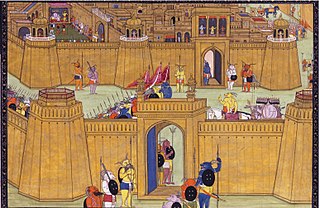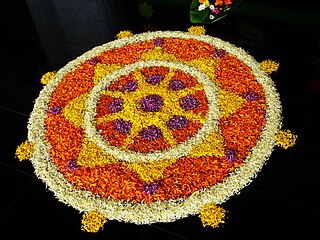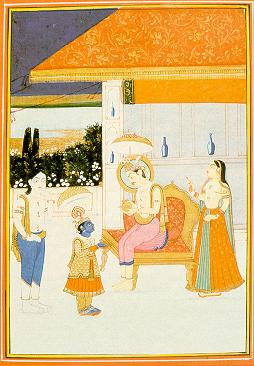
Vamana also known as Trivikrama, Urukrama, Upendra, Dadhivamana, and Balibandhana, is an avatar of the Hindu deity Vishnu. He is the fifth avatar of Vishnu and the first Dashavatara in the Treta Yuga, after Narasimha.

Lanka is the name given in Hindu epics to the island fortress capital of the legendary asura king Ravana in the epics of the Ramayana and the Mahabharata. The fortress was situated on a plateau between three mountain peaks known as the Trikuta Mountains. The ancient city of Lankapura is said to have been burnt down by Hanuman. After its king, Ravana was killed by Rama with the help of Ravana's brother Vibhishana, the latter was crowned king of Lankapura. His descendants were said to still rule the kingdom during the period of the Pandavas. According to the Mahabharata, the Pandava Sahadeva visited this kingdom during his southern military campaign for the rajasuya of Yudhishthira. The palaces of Ravana were said to be guarded by four-tusked elephants.

Onam is an annual harvest and cultural festival related to Hinduism that is celebrated mostly by the people of Kerala. A major annual event for Keralites, it is the official festival of the state and includes a spectrum of cultural events.

Mahabali, also known as Bali, Indrasenan, or Māveli, is a daitya king featured in Hinduism. He is the grandson of Prahlada, and a descendant of the sage Kashyapa. There are many versions of his legend, in ancient texts such as the Shatapatha Brahmana, Ramayana, Mahabharata, and several Puranas. According to Hindu literature, he was blessed to be one of the Chiranjivi, a group of seven immortals, by the Vamana avatar of Vishnu and reigns in the Sutaloka.

The Saptarshi are the seven seers of ancient India who are extolled in the Vedas, and other Hindu literature such as the "Skanda Purana". The Vedic Samhitas never enumerate these rishis by name, although later Vedic texts such as the Brahmanas and Upanisads do so.
The Chinas, Cīna, or Chīnaḥ are a people mentioned in ancient Indian literature from the first millennium BC and first millennium AD, such as the Mahabharata, Laws of Manu, and the Puranic literature.
The Panchala kingdom was one of the historical Mahajanapadas of ancient India. It was annexed into the Nanda Empire during the reign of Mahapadma Nanda. Ahichchhatra was capital of northern Panchala and Kampilya was capital of southern Panchala.
Sakas are described in Sanskrit sources as a Mleccha tribe grouped along with the Yavanas, Tusharas and Barbaras. There were a group of Sakas called Apa Sakas meaning water dwelling Sakas, probably living around some lake in central Asian steppes. Sakas took part in Kurukshetra War.
Konkana was a southern kingdom populated by Brahmins during and after the period of Puranas. This kingdom is identified to be the Konkan region of Maharashtra. Other such Brahmin populated kingdoms includes Dravida, Andhra and Karnata. They have migrated in the later periods to the south as far as Kerala.
Kalinga is a kingdom described in the legendary Indian text Mahabharata. They were a warrior clan who settled in and around the historical Kalinga region, present-day Odisha and northern parts of Andhra Pradesh. According to political scientist Sudama Misra, the Kalinga janapada originally comprised the area covered by the Puri and Ganjam districts.reference-Sudama Misra (1973). Janapada state in ancient India. Bhāratīya Vidyā Prakāśana. p. 78.
Dravida is mentioned as one of the kingdoms in the southern part of present-day mainland India during the time of the Mahabharata.
Karnata was an ancient kingdom, mentioned in the great epic Mahabharata, It gave the name to the South Indian state of Karnataka.
Kanchi was a southern kingdom mentioned in the epic Mahabharata. This kingdom took part in the Kurukshetra War.
Saraswata Kingdom was an ancient kingdom, territory or region that was situated on the banks of the river Sarasvati River during the pre-historic ages. This region is mentioned in detail in as many as 20 chapters in the Mahabharata from (9:35) to (9:54). Balarama traced the Saraswati river through its partially dried up course from the ocean near Prabhasa to its origin in the Himalayas.

Kirata Kingdom in Sanskrit literature and Hindu mythology refers to any kingdom of the Kirata people, who were dwellers mostly in the Himalayas. They took part in the Kurukshetra War along with Parvatas (mountaineers) and other Himalayan tribes.

Ulagalandha Perumal Temple is a temple dedicated to Vishnu located in Kanchipuram, Tamil Nadu, India. Constructed in the Dravidian style of architecture, the temple is glorified in the Naalayira Divya Prabandham, the early medieval Tamil canon of the Alvar saints from the 6th through 9th centuries CE. It is one of the 108 Divya Desams dedicated to Vishnu, who is worshipped as Ulagalantha Perumal, and his consort Lakshmi as Amuthavalli. The temple is believed to have been built by the Pallavas, with later contributions from the medieval Cholas, Vijayanagara kings, and Madurai Nayaks.

Balipratipada, also called as Bali-Padyami, Padva, Virapratipada or Dyutapratipada, is the fourth day of Diwali, the Hindu festival of lights. It is celebrated in honour of the notional return of the daitya-king Bali (Mahabali) to earth. Balipratipada falls in the Gregorian calendar months of October or November. It is the first day of the Hindu month of Kartika and is the first day of its bright lunar fortnight. In many parts of India such as Gujarat and Rajasthan, it is the regional traditional New Year Day in Vikram Samvat and also called the Bestu Varas or Varsha Pratipada. This is the half amongst the three and a half Muhūrtas in a year.

Kazheesirama Vinnagaram or Tadalan Kovil or Tiruvikrama (trivikara) Perumal Temple is a temple dedicated to Vishnu located in Sirkazhi, Tamil Nadu, India. Constructed in the Dravidian style of architecture, the temple is glorified in the Nalayira Divya Prabandham, the early medieval Tamil canon of the Alvar saints from the 6th–9th centuries CE. It is one of the 108 Divya Desam dedicated to Vishnu, who is worshipped as Trivikrama and his consort Lakshmi as Loganayagi. The temple is believed to have been built by Cholas, with later contributions from Medieval Cholas, Vijayanagara kings, and Madurai Nayaks.

Ulagalantha Perumal Temple or Trivikrama Temple is a Hindu temple dedicated to Vishnu located in Tirukkoyilur, Tamil Nadu, India. Constructed in the Dravidian style of architecture, the temple is glorified in the Naalayira Divya Prabandham, the early medieval Tamil canon of the Alvar saints from the 6th–9th centuries CE. It is one of the 108 Divya Desams dedicated to Vishnu, who is worshipped as Ulagalantha Perumal and his consort Lakshmi as Poongothai. The temple is believed to have been built by the Medieval Cholas, with later contributions from Vijayanagara kings and Madurai Nayaks. The temple covers an area of 5 acres (20,000 m2) and has a temple tower that is the third tallest in Tamil Nadu, measuring 192 ft (59 m) in height.
Kratu is described as one of the manasaputras, the mind-born children of the creator deity, Brahma, in Hinduism. He is also a rishi, who appears in two different ages.









